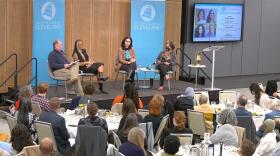In Cleveland’s Central neighborhood, traffic whizzes by on Central Avenue, a street dotted with businesses. If you glance down any of the side streets, you’ll see rows of homes. One thing that’s hard to find, however -- trees.
Cleveland-native Samira Malone grew up in this neighborhood. She has many fond memories, but she says even as a young girl, she knew there was something missing.
“One of the things that always just alarmed me was the fact that there were it was so gray, everything was so gray and brown and built out and very little refuge for, being connected to the environment and Earth.”
Malone calls herself a professional tree hugger. She’s director of the , a collaborative urban forestry organization that partners with the city. Through the coalition, Malone works to find ways to reestablish the Forest City’s connection to its roots.

Trees can reduce risk of asthma and cardiovascular disease, and can improve mental health, Malone said. Tree canopy can also cool down communities, driving down utility costs at home.
An ideal, healthy baseline for canopy is about 30%, she said, but Cleveland’s numbers are closer to 18%.
“If you look at any redlining map, historical policy and practice -- especially disinvestment in Black and brown communities -- is a direct correlation to why there is a disproportionately low tree canopy in Black and brown neighborhoods, primarily concentrated on the east side of Cleveland,” Malone said.
The city is currently planting between 3,000 and 5,000 trees each year, Malone said, but meeting the city’s 30% goal will take 28,000 trees and upwards of $100 million.

In Northeast Ohio, a region where growth was driven by its once-booming industrial sector, canopy loss is commonplace. In places like Youngstown, residents know the feeling of lacking trees all too well.
Jack Daugherty is the neighborhood stabilization director for the .
“Our city is struggling to keep after that problem because it's such a big one,” he said. “There are thousands of trees, mature tree lawn trees that are dead or dying and are falling, and that's created a big frustration for folks in their neighborhoods.”
Youngstown’s shrinking population creates a declining tax base, that Daugherty said means less funding for maintenance of the existing canopy.
“We have a city built for 250,000 people and 60,000 people living in it,” he said. “So, all of the problems you would think of related to that, not having that tax base to support all of that infrastructure and trees are very much a part of our infrastructure.”
The Mahoning Valley Tree Corps. is working with the city of Youngstown and other partners to train urban foresters to help with the maintenance and removal of unhealthy or unsafe trees, Daugherty said.

It’s expensive work, he said, but a $5 million grant from the U.S. Department of Agriculture through the Biden Administrations’ Inflation Reduction Act will support restoration efforts in Youngstown and Warren for the next five years.
“Not too much is out there in terms of resources to tackle this problem, and most of the grants and resources available are very limited,” Daugherty said. “But this is really going to be a huge boost to our community wide effort in Mahoning Valley to tackle the issue.”
Grants are a big part of restoration work in Canton, where tree canopy decreased primarily due to development during the height of the city’s heavy manufacturing industry.
“The current canopy showed the lowest amount of tree cover was going to be near downtown area, and then a lot of it, too, was going to be in the areas that we had a lot of the industry,” Kristine Griffith, GIS coordinator with the city’s Engineering Department, said. “Then the more you kind of sprawl it out to where the townships, are was going to be the higher tree canopy cover.”
There have been a few prior attempts at increasing the tree canopy, Griffith said.
“At one time there was a lot of maple trees that were planted, and it made these corridors look beautiful,” she said. “But what we're finding out is as they grew, they were heaving our sidewalks, causing damage to sidewalks, causing damage to different sewer lines.”
This time, they’re thinking ahead to avoid repeating past mistakes, Griffith said, by considering things like tree species, height and the location of utilities above and below ground to ensure trees that are planted will work well in the environment.
A renewed focus on canopy restoration came about a decade ago, after the city hired an urban forester. The city uses mapping tools to find areas that were good for planting.
“We identified the species of the trees, if there's been any kind of damage, if there's replacement [trees],” she said. “We’ve also identified spots that maybe a tree was planted and it died, and we plant another one and it died. So, we know that maybe there's just bad soil in that area.”
The city of Canton has received several state and federal grants for the work since they began in 2016, Griffith said. But to continue, they will need additional funding.

Tree canopy was the focus at the City Club of Cleveland’s Friday forum last week, where participants discussed the intersections between canopy, economic development, racial equity and more.
Samira Malone was one of the panelists at that forum. Malone called trees a worthwhile investment not just in promoting economic development, but in accomplishing several of quality-of-life goals.
“It also feels to me, not just environmental justice,” she said, “but an act of racial restorative justice.”
The Cleveland Tree Coalition will continue its efforts to reforest neighborhoods like Central, Malone said, this time with a special focus on education.
“Educating not only just residents,” she said, “but policymakers, decision makers, organizations and institutions about the importance and value of trees, and that trees play a critical role in our urban ecosystem.”









